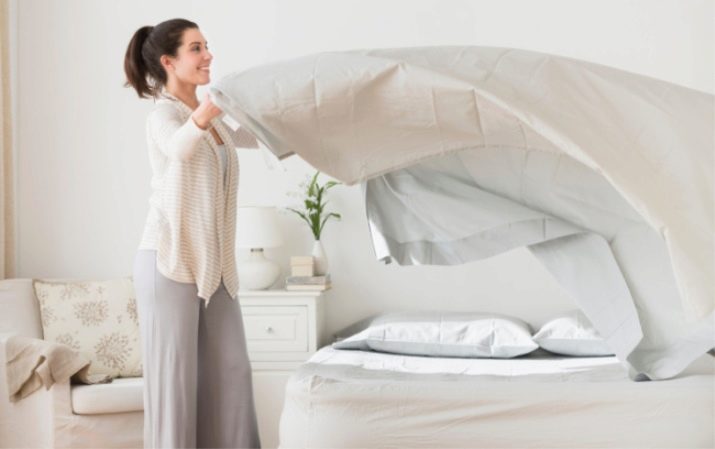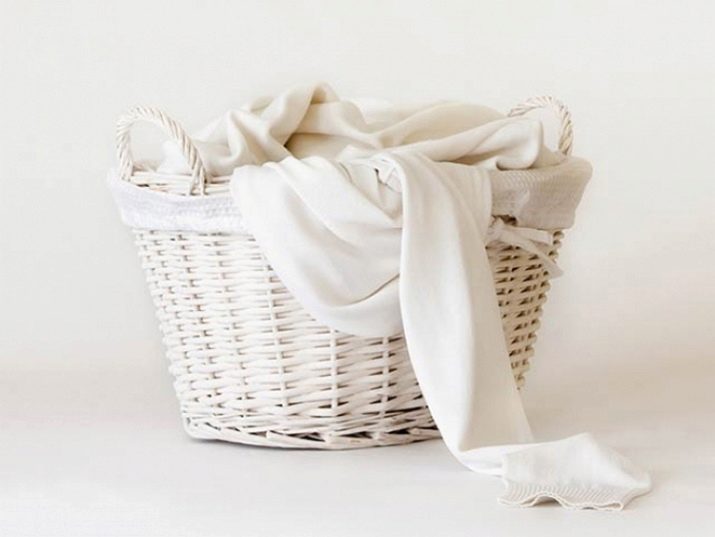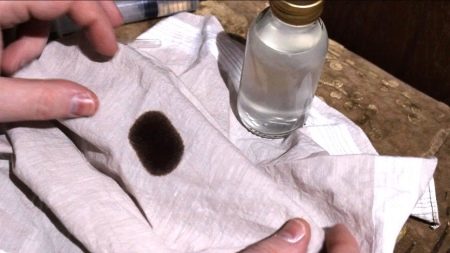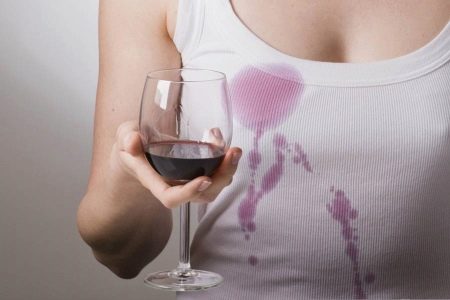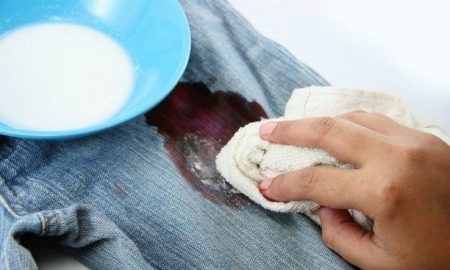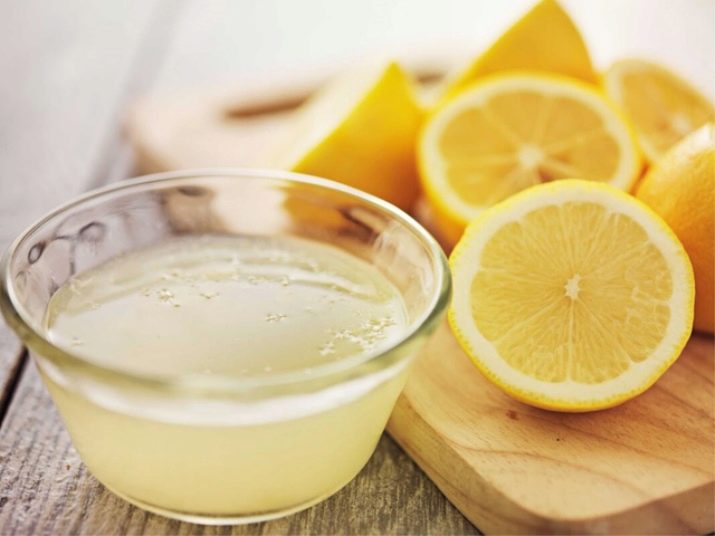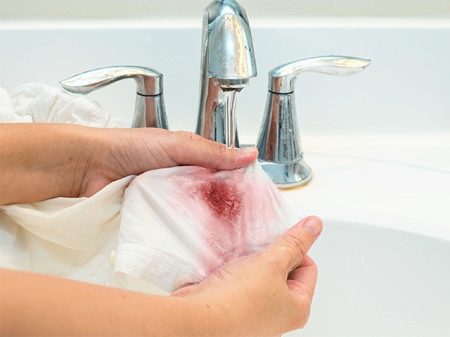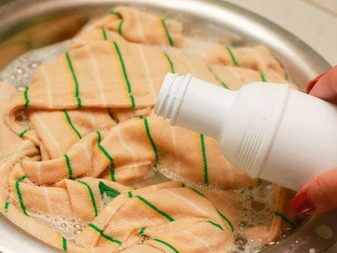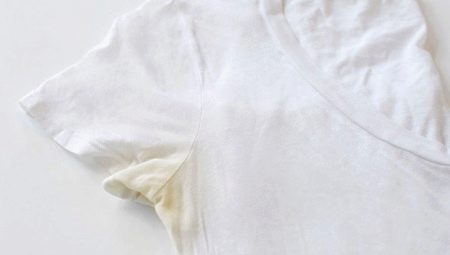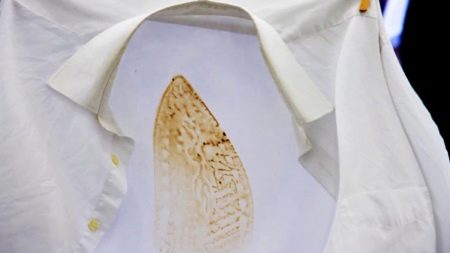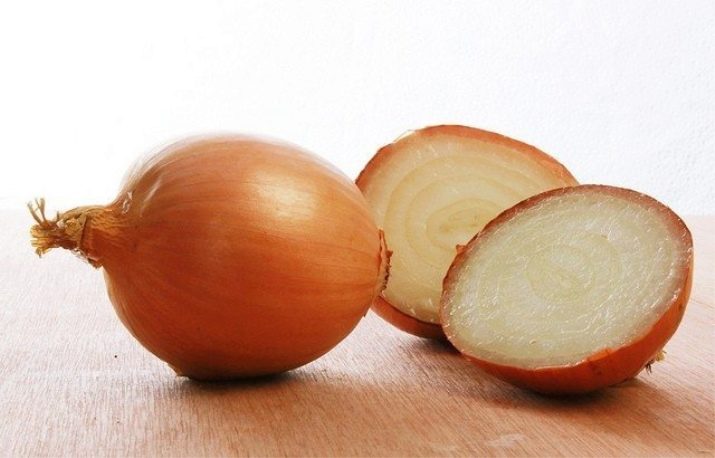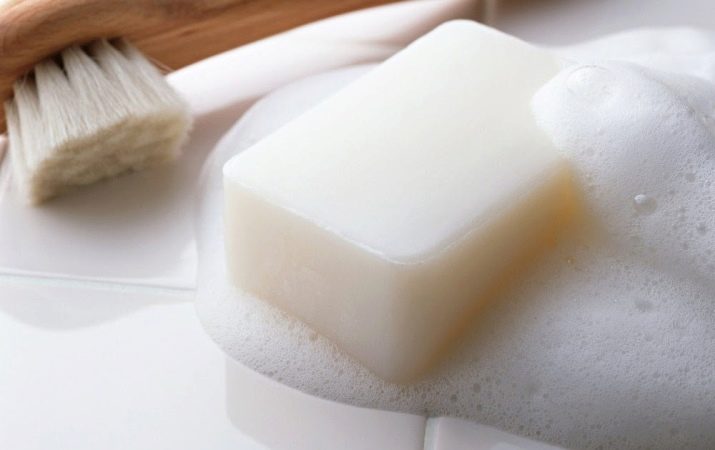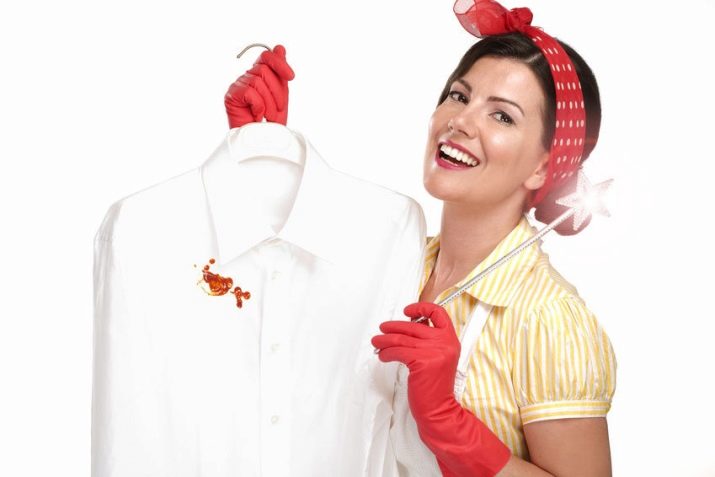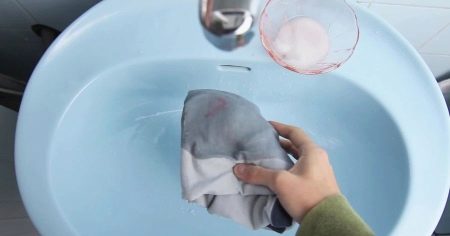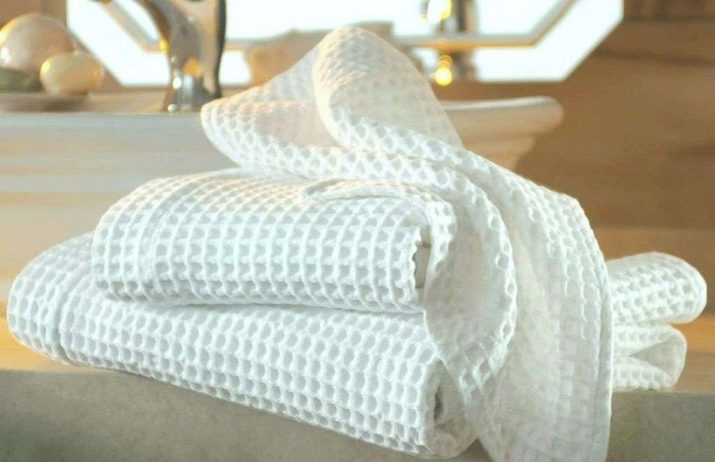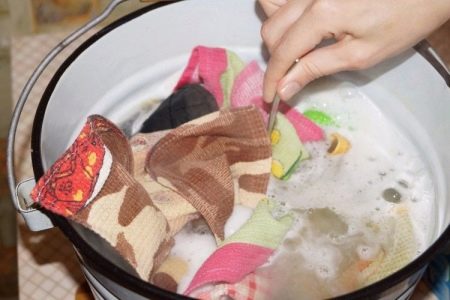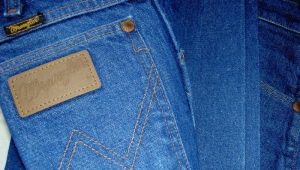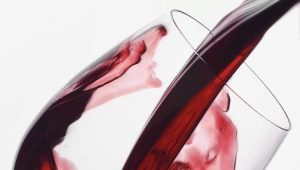How to effectively wash off stains?
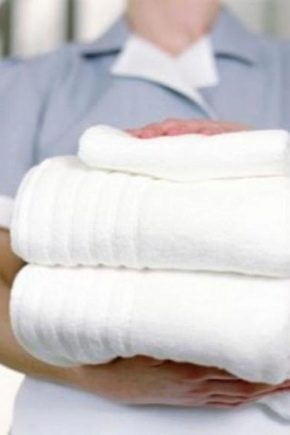
Contamination on various surfaces can occur for a variety of reasons. Spots of absolutely any origin can permanently spoil the thing. Old mud causes the most problems. It is important for each housewife to know how to effectively clean the most diverse stains without damaging the fabric.
Cleaning features
Peculiarities of the removal of a particular contamination depend on its origin, as well as the material on which the stain was formed.
It is impossible to use the same tool for cleaning all types of fabrics. Delicate materials are more sensitive to aggressive chemicals.
Effectively to remove pollution, without damaging the fabric, some recommendations will help:
- If possible, examine the label before handling the item. Pay attention to the type of fabric, as well as the temperature of the water at which you can wash the product.
- Fresh dirt is much easier to remove than stained spots. A soiled item should be immediately soaked in warm water. Fresh traces of fruits and berries can often be washed with ordinary powder.
- Stain remover is quite aggressive in the fight against stains. On colored clothes such a composition is not recommended.
At home, you can remove almost any pollution, if you know a number of rules. When choosing the means and method of cleaning the product, use the following tips:
- You should not expose artificial silk items to acids, solvents, and hydrogen peroxide without first checking a small section of fabric for reaction with these substances.
- Leatherette is sensitive to the effects of aggressive substances (solvents, technical alcohol, gasoline). Wipe stains from artificial leather is desirable only with the help of a soap solution.
- Fruit traces can be easily removed using one-to-one vodka and glycerin solution.
- Old contamination of unknown origin is derived using butter and gasoline. Stain smeared with butter or margarine and after a while rubbed with a cloth dipped in gasoline. After this treatment, clothes must be washed.
- To bring traces of red wine with cotton cloth will help boiled milk.
- Lipstick marks on woolen and silk products can be scrubbed with medical alcohol.
- Clothes soiled in the hair dye mixture can be cleaned with sodium hydrosulfite solution. To prepare the solution, one teaspoon of sodium hydrosulfite must be mixed with a glass of water. The mixture must be heated to sixty degrees and treat it contaminated surface.
- Traces of potassium permanganate will completely disappear if wetted with whey and left for four hours for better absorption. After that, the thing must be washed.
What to use?
To remove stains, you can use both special household chemicals and traditional cleaning methods.
When choosing a suitable method of removing stains, it is necessary to consider the type of stained tissue and the type of contamination itself.
Consider the most common tools that are used to remove dirt on various materials:
- Acetic essence. Rarely used to remove stains in its pure form. Most often it is a component of specially prepared solutions to remove contaminants.
- Lemon juice or citric acid.
- Food salt.
- Laundry detergent can cope with simple and fresh stains. Also, the powder is needed in the final washing after treatment with special compounds.
- Laundry soap is a gentle way to remove stains. This soap washes well fresh stains from berries and fruits. It can also be used for soaking things before further cleaning.
- Soap and stain removers in the form of powder or gel "Antipyatin." This tool is better to use for processing things from natural durable fabrics. For colored clothes use "Antipyatin" need with extreme caution.
- Hydrogen peroxide is suitable for removing stains from white fabrics.
- Ammonia can be used as an alternative to hydrogen peroxide. The disadvantage of ammonia is the characteristic sharp smell.
A universal remedy in the fight against most types of stains is baking soda. Sodium bicarbonate is safe for health and can cope with both fresh and old contaminants. Soda can be added when washing in its pure form, or make special solutions from the substance.
If you add three tablespoons of sodium bicarbonate when washing in a washing machine, you can get rid of yellow, gray and greasy stains on clothes.
Soda ash more effectively copes with various types of pollution. Sodium carbonate can be used to make gel for washing laundry, which will not be inferior in quality to household chemicals. To prepare the detergent, you will need soap (0.2 kg), sodium carbonate (0.2 kg) and two and a half liters of water. The process of making the gel is as follows:
- Soap must be grated. Soap chips should be mixed with water (one and a half liters) and put the container with the solution on the gas stove. Bring to a boil the mixture is not necessary. When heating the solution must be constantly stirred.
- After the soap chips completely dissolve, add one liter of water to the heated mixture.
- Continuing to heat the soap solution over low heat, you need to gradually add sodium carbonate, carefully stirring the mixture.
- After the mixture becomes homogeneous, the fire must be turned off. The solution is left to cool for a day, after which you can pour the composition into a plastic container with a wide neck.
How to wash at home?
It is not always possible to effectively use the services of dry cleaning for the removal of stains. There are many effective ways to clean the dirt at home. The final result will depend on the choice of the stain removal method. Therefore, before washing it is important to consider the type of fabric, the cause of stains, as well as the degree of contamination.
Fresh spots
Fresh stains are much easier to scrub than old stains. In certain cases it will be enough to soak the thing in a soap solution, and then wash it in the washing machine. However, certain contaminants require the use of special tools.
Fresh dirt from the resin must first be mechanically treated. Using a knife or other sharp object, the resin should be cleaned from the clothes, after which you can proceed to other ways of handling pollution. The stain can be treated with purified gasoline, alcohol or nail polish remover and leave for twenty minutes.
The newly appeared beet stain can be removed using a mixture of medical alcohol (one glass) and citric acid (a teaspoon). In the resulting solution you need to soak the thing for thirty minutes, then rinse in cool water. Well absorbs such pollution and simple table salt. Sprinkle with beetroot sprinkle with salt and leave for fifteen minutes. If the stain has not disappeared, the procedure must be repeated.
If the beet residue remains on the sofa, then the surface should be immediately treated with soapy water. If it was not possible to remove the stain in this way, it is better to resort to special cleaning products for upholstered furniture.
When cleaning the sofa from various kinds of dirt, it is worth remembering that the procedure is carried out in the direction of the pile, otherwise the stain may spread.
The tea spilled on clothes instantly paints fabric. It is necessary to get rid of this kind of pollution as quickly as possible so that the drink does not have time to penetrate deep into the structure of the tissue. The easiest way is to rub the contaminated area with soap and wash the problem area under cool water. However, this method can only help in the fight against the newly appeared tea stain.
Clothes that have been spilled on tea can be soaked in a solution of vinegar and water (in a one-to-one ratio). After twenty minutes, the thing must be rinsed. The stain should disappear completely.
Grass stains are a fairly common contamination on children's clothes. You can get rid of traces of plants on the fabric with the help of vinegar, a solution of edible salt or ammonia. To obtain a salt mixture, you need to mix a tablespoon of table salt and one hundred milliliters of water. The mixture is treated with pollution, after which the thing is washed in a washing machine.
To prepare the ammonia solution, you need to take a tablespoon of ammonia and two glasses of water at room temperature. The resulting composition is treated with a contaminated surface, after which the stain is rubbed with laundry soap and left for one hour. The finished item should be washed in any convenient way.
Fruits and berries
Food stains are one of the most common types of dirt on clothes or furniture. Especially often parents of small children face such a problem. The sources of pollution are mainly fruits, sugary drinks, chocolate and berries. Even the seemingly almost colorless banana flesh can leave unpleasant traces on any tissue.
Banana stains should preferably be removed within a few hours after their appearance. Old contamination will be much harder to remove.
When choosing a method of cleaning things should take into account the type of contaminated tissue. With delicate materials, great care must be taken.
Banana stains on light-colored fabric can be reduced with lemon. Contaminated surface must first be moistened with water at room temperature, and then treated with half a lemon, leaving for thirty minutes for better absorption. After that, the thing must be washed with the usual powder.
Hydrogen peroxide helps to cope with pollution from a banana no less effectively. However, this tool is not suitable for all types of fabrics. Using this method of cleaning on delicate fabrics is not recommended.
The contaminated area must be rubbed with a cotton pad moistened with hydrogen peroxide. After that, under the stain and on it you need to put one cotton pad in a three percent peroxide solution. Thirty minutes later, the thing can be washed in the usual way.
Wash cherry juice with light clothes made of natural fabric can be using boiling water. Thing need to stretch over the sink or bathroom. Spread boiling water through the cherry stain with a small stream, and fresh pollution will completely disappear.
To remove stains from cherries and blueberries with a light cloth, use lemon juice (one tablespoon) and vinegar (one tablespoon). Clean jeans from fresh fruit and berry stains can be using salt. Apply a thick layer of salt to the contaminated area and leave for five minutes. After that, the thing must be washed in a washing machine.
Traces of apricot fruit or juice can permanently spoil the thing, if not to remove such contamination promptly.The first step is to clean the apricot pulp from the fabric, removing it with a knife. To prevent the spread of stains, it is advisable to blot the contaminated area with a clean cloth.
Soak clothes with apricot stains can only be in cool water. Hot water will only contribute to dyeing the fibers of the fabric with coloring pigments contained in the fruit.
You can try to remove fresh stains with a stain remover. However, this tool is not suitable for all tissues.
Pomegranate juice is a natural dye and is extremely difficult to remove from clothes. Gnawed stains from a pomegranate can be tried to remove only with special stain removers. With fresh traces will help to cope and improvised means.
Garnet-contaminated tissue can be treated with soda solution. To do this, one teaspoon of soda must be diluted in a glass of warm water. The mixture is rubbed on the stain and left until the garnet wake is completely gone.
Mold
In addition to food contamination, more unpleasant stains may appear on clothing. Under the influence of dampness, a thing can become covered with mold. However, the presence of such contamination on the fabric does not mean that the thing must be immediately thrown away. There are many effective ways to combat fungal formations on clothing.
There are both universal methods for removing molds and special ones for a certain type of fabric. Consider some cleaning methods that are suitable for most things:
- It is necessary to prepare a solution of water (one liter), edible salt (two tablespoons) and ammonia (five drops). All components are thoroughly mixed, after which the mixture must be boiled for half an hour. The solution is applied to the areas affected by fungus for a quarter of an hour, after which the treated surface must be cleaned using a brush.
- Sodium thiosulfate (one tablespoon) must be mixed in one glass of water at room temperature. The resulting solution is applied to areas of tissue affected by the fungus. Fifteen minutes later the spots should disappear completely.
- Mold stains can be treated with methylated spirits.
- Remove fungal formations on a white cloth, you can use the "Whiteness".
Traces of sweat and deodorant
Armpits in the armpits in the form of white traces of deodorant or yellow sweat stains are difficult to remove. The composition of antiperspirants includes special components that leave difficult-to-remove white stains on the fabric. Sweat is able to penetrate deep into the fibers of the material, and deodorant only increases the degree of contamination.
Traces of white color from antiperspirant over time acquire a yellow tint, and it becomes even more difficult to remove them. For this reason, such spots should be fought immediately after they appear. No need to soak things in hot water - high temperatures will only aggravate such pollution. Apply cleaning products to stains from an antiperspirant need from the very edges, gradually moving to the center.
At removal of yellow traces from white fabric it is not necessary to use solutions which part chlorine is. Such tools will not help get rid of the yellow shade, and make it even more bright and noticeable.
Fresh traces of sweat and antiperspirant can be cleaned with soap. Thing you need to soak in soapy water, or rub the contaminated area with a means and leave for thirty minutes. After treatment of stains, clothes should be rinsed and washed in a washing machine.
White things can be cleaned of such contaminants using hydrogen peroxide. The tool should be applied to areas with yellowness and leave for twenty-five minutes, after which the clothes are washed in the usual way. Instead of peroxide, you can use lemon juice.
White color on black things can be removed with vodka. This method is not suitable for delicate fabrics.. Stains must be treated with vodka, after which the clothes are washed in the usual way.
Clothes made from natural fabrics can be cleaned of contamination with vinegar. Contaminated areas are blotted in solution. An hour after applying the vinegar things can be washed in a washing machine.
Eaten yellowness can be removed with aspirin tablets. From the crushed tablets and water prepare a slurry and rub it with stains on clothes. The tool is kept on the fabric for three hours, after which the thing must be washed.
From iron
If the iron is used improperly, unpleasant contamination may appear on the clothes. On light things, yellow traces are formed, and on dark things - glossy spots. Most often, this kind of contamination is formed on synthetics, since the top layer of such a fabric can melt under the influence of high temperatures, leaving behind a bright trace.
The iron stain on dark trousers can be removed with a simple ironing of the problem area through gauze or thin fabric dipped in soapy water.. The solution should be sufficiently concentrated. Strong pressure on the iron during ironing is not worth it.
A small shiny stain on black clothes will help remove the vinegar. In a solution of vinegar and warm water, the contaminated thing is soaked for one hour, and then dried naturally. Wash clothes after soaking is not necessary.
Onions are a universal means of dealing with iron marks that is suitable for most types of fabric. The bulb must be cut into two parts and treated with the side of the cut contaminated surface until the shiny trail completely disappears. Then the thing needs to be rinsed and dried.
You can clean a shiny stain from synthetics with boric acid. The problem area is treated with acid and left for fifteen minutes, after which the thing must be washed and dried well.
Long-term pollution
It is not always possible to completely remove stubborn stains. To remove the old pollution, you need to put much more effort than when removing fresh stains.
Old traces of berries, you can try to remove from the products with soap. Contaminated area should be generously rubbed with soap and leave for thirty minutes. After that, the thing should be rinsed in warm water. If the stains are significantly paler, then you can wash the clothes in a washing machine. Otherwise, the procedure for processing soap must be repeated.
The disadvantage of this method is that The process of cleaning up old contamination with soap can take a lot of time. However, it is worth noting that this method is absolutely safe for processing delicate materials and jeans.
Antipyatin is a more effective remedy for removing old stains. However, like other types of stain removers, Antipyatin can spoil colored things.
Stubborn berries from white tissue can be removed using hydrogen peroxide. Hydrogen peroxide is necessary to treat the contaminated surface and leave for thirty minutes. After that, the thing is washed by hand or in a washing machine. This tool also effectively removes old chocolate stains on white clothes. It is enough to apply peroxide to the contaminated area for fifteen minutes, then rinse things in cool water.
One of the most difficult to remove old pollution are traces of blood. If you can try to clean a fresh spot quickly, then it is not always possible to remove blood that has been eaten from your clothes.
In no case should bloody marks be treated with hot water. The blood contains protein, which collapses under the influence of high temperatures. After coagulation, the protein cannot be removed from the tissue fibers: a yellowish blood mark remains forever on the clothes.
Clothes with old bloody marks should be soaked in saline. For two liters of cold water, you must take two tablespoons of salt. Clothing is soaked in the resulting composition for ten hours, after which the thing must be washed in the usual way in warm or hot water.
Kitchen towels are constantly exposed to various types of dirt. Traces of food enter the tissue and are difficult to remove. When washing kitchen towels need to use a special method. Towels must first be soaked in a special solution. The solution can be made as follows:
- On the fire, you need to bring a large pot of water to a boil.
- Three tablespoons of refined vegetable oil and powdered bleach are poured into boiling water. In the resulting solution mix one cup of washing powder.
- All components are thoroughly mixed in water. The pot is removed from the heat.
In the resulting composition soaked towels to cool the mixture. Stubborn dirt should completely recede, and after soaking, it will be enough just to rinse the products.
An easier way to remove dirt from kitchen towels is to soak in salt water for one hour. To prepare the solution, it is necessary to fill a small basin of cool water and dilute five tablespoons of salt in it. After the soaking procedure, the towel must be washed with detergent to completely remove dirt.
Useful tips and tricks
With proper care, things can be avoided. First of all, when even the smallest stain on fabric appears, contamination needs to be treated. and remove as soon as possible. This will prevent the penetration of dirt deep into the fabric fibers.
One of the most unpleasant and hazardous types of pollution is mold. Fungal formations can appear not only in rooms with a high level of humidity, but also on clothing. So that you do not have to deal with the problem of removing mold from clothes, it is better to take care of protecting your favorite things in advance:
- After washing things must be well dried. Fungal formations may appear on wet clothing.
- It is not allowed to store things in places with high levels of humidity.
- At the first signs of mold on clothes you should immediately soak the thing in hot water. Consider the characteristics of the material, and do not expose the fabric to temperatures that could harm it.
Stains from deodorant and sweat are also difficult to remove. To prevent the appearance of yellow marks in the armpits, consider the following recommendations:
- When buying an antiperspirant, pay attention to its composition. Among the components should not be aluminum salts. Such substances contribute to the appearance of yellow marks on clothes.
- Clothes should be worn only after the deodorant is completely dry on the skin.
- For clothing there are special pads that protect the armpit area from contamination.
How to quickly remove stains from clothes, see the next video.
